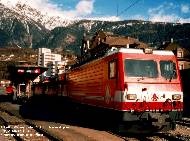
BVZ

Multipurpose locomotive HGe 4/4 II for operation on adhesion and cog wheel
lines
 In order to cope with the total traffic over the Brünig pass, the
SBB Brünig Railway had 16 Deh 4/6 901-916
traction units at its disposal at the beginning of the eighties. These dated from the
beginning of the electrification era (years of manufacture 1941/1942) and could
therefore not conceal their weakness due to age in daily operation on the Brünig
pass up-grades of up to 120 o/oo. Both of the mountain locomotives HGe 4/4 I 1991-1992
purchased in 1953 could never show really convincing performance due to their serious
deficiencies. Therefore in the early seventies, the train development and workshop
department started design of a novel traction unit. Furthermore, the BVZ Zermatt
Railway (BVZ) and the Furka-Oberalp Railway (FO)
as well as the Luzern-Stans-Engelberg Railway (LSE)
signaled their interest in new traction units.
In order to cope with the total traffic over the Brünig pass, the
SBB Brünig Railway had 16 Deh 4/6 901-916
traction units at its disposal at the beginning of the eighties. These dated from the
beginning of the electrification era (years of manufacture 1941/1942) and could
therefore not conceal their weakness due to age in daily operation on the Brünig
pass up-grades of up to 120 o/oo. Both of the mountain locomotives HGe 4/4 I 1991-1992
purchased in 1953 could never show really convincing performance due to their serious
deficiencies. Therefore in the early seventies, the train development and workshop
department started design of a novel traction unit. Furthermore, the BVZ Zermatt
Railway (BVZ) and the Furka-Oberalp Railway (FO)
as well as the Luzern-Stans-Engelberg Railway (LSE)
signaled their interest in new traction units.The FO reckoned with a strong traffic
increase because the opening of the Furka tunnel was imminent (opened in 1982). High
growth rates were expected at that time especially with locomotive-drawn trains in
transit traffic. The six HGe 4/4 I locomotives built in the forties proved however
inadequate for these trains due to their low maximum speed and their susceptibility to
breakdowns. Therefore a decision was made to procure a new series of locomotives
together with the SBB.
At the beginning of 1983, the manufacture of a preliminary
series of five units was given in commission. Three units (101-103) were for the FO,
two for the SBB (1951-1952). It was also agreed at the same time that, with the delivery
of the eight SBB series locomotives in 1985/86, the two SBB-prototypes would be handed
over to the FO after corresponding adaptations.
The locomotive body was manufactured
in lightweight steel construction and weighed alone only 5.8 tons! In order to minimize
stresses resulting from the rack-and-pinion and the traction wheels, a novel
differential drive developed by SLM was used. All four axles are each driven by a
pulsating-current traction motor. These are fed by two two-quadrant power converters of
the oil-bath type.
The locomotives have regenerative brakes independent of the
overhead contact wire, whose switching has been adopted by the local transit shuttle
trains. The traction control electronics base on ABB’s microprocessor controlled
MICAS-S system and consists of two identical units.
Since the vehicles' performance prooved satisfactory the FO ordered an additional number of three units. In addition to that the BVZ received five identical locomotives in 1990 so that a total number of 21 cog wheel locomotives of type HGe 4/4 II are in service in Switzerland.
Technical facts
| Vehicle designation: | HGe 4/4 II |
|---|---|
| Vehicle Nos: | 1 - 5 |
| Manufacturer - mechanical parts: - electrical parts: | SLM ABB |
| Wheel arrangement: | Bo'Bo' |
| Years of commissioning: | 1990 |
| Number of vehicles: | 5 |
| Max. speed: | 90 km/h / 40 km/h (cog wheel, uphill) |
| Gauge: | 1,000 mm |
| Length over buffer: | 14,776 mm |
| Overall width: | 2,683 mm |
| Mass in running order: | 64.0 t |
| Hauling load: - ruling up-gradient: | 150 / 130 / 350 t 4 / 11 % / Furka-Tunnel |
| Nominal catenary line voltage: | 11 kV, AC 16 2/3 Hz |
| Number of traction motors: | 4 |
| Max. rating at wheel rim (1 hour): | 1,932 kW |
| Cont. rating at wheel rim: | 1,778 kW |
| Max. tractive effort at wheel rim (1 hour): - corresponding speed: | 149.6 kN 45,2 km/h |
| Cont. tractive effort at wheel rim: - corresponding speed: | 141.2 kN 45,6 km/h |
| Starting tractive effort at wheel rim: | 230 kN / 280 kN (cog wheel) |
| Bogie wheel base: | 2,980 mm |
| Diameter of wheels (new): | 943 mm |
Vehicle names
| Vehicle names | |
|---|---|
| - 1: | Matterhorn |
| - 2: | Monte Rosa |
| - 3: | Dom |
| - 4: | Weisshorn |
| - 5: | Mount Fuji |
Copyright © 1997
Author: Klaus P. Canavan, last change on 2002-01-19